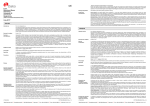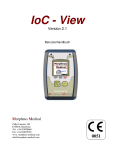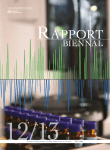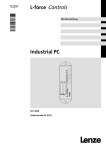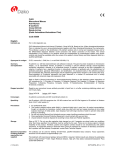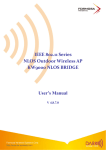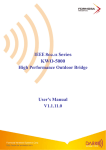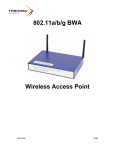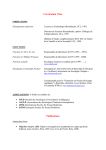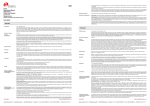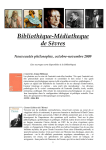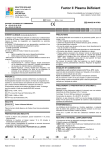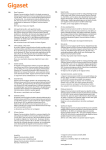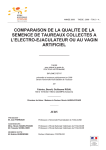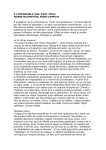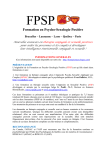Download 0843 FLEX Polyclonal Rabbit Anti-Human Prostate-Specific
Transcript
for information on re-programming of the protocol. Verify that the performance of the adjusted protocol is still valid by evaluating that the staining pattern is identical to the staining pattern described in “Performance characteristics”. 0843 FLEX Polyclonal Rabbit Anti-Human Prostate-Specific Antigen Ready-to-Use (Dako Autostainer/Autostainer Plus) Code IS514 Counterstaining in hematoxylin is recommended using EnVision FLEX Hematoxylin (Dako Autostainer/Autostainer Plus) (K8018). Nonaqueous, permanent mounting medium is recommended. Positive and negative controls should be run simultaneously using the same protocol as the patient specimens. The positive control tissue should include prostate and the cells/structures should display reaction patterns as described for this tissue in “Performance characteristics” in all positive specimens. The recommended negative control reagent is FLEX Negative Control, Rabbit (Dako Autostainer/Autostainer Plus) (Code IS600). Staining interpretation The cellular staining pattern is cytoplasmic. Performance characteristics Normal tissues: The antibody strongly labels prostatic epithelium. No labeling was observed in 34 other human tissues, including brain, skin, muscle, nerve, breast, lymph node, spleen, thymus, different parts of the respiratory, digestive, urinary and genital systems (5). Abnormal tissues: All 60 studied prostate carcinomas (Gleason pattern 3-5) showed diffuse positive labeling by the antibody. The percentage of PSA-positive cells was >95% in 57/60 of the carcinomas (6). The antibody labeled 3/15 (20%) ductal breast carcinomas and 2/7 (28%) apocrine breast carcinomas showed patchy areas of immunoreactive cells (5). 310 nonprostatic tumors including 40 breast adenocarcinomas, 40 lung adenocarcinomas, 40 colonic adenocarcinomas, 40 renal cell carcinomas, 40 urothelial carcinomas, 30 glandular lesions of the urinary bladder, 40 carcinoid tumors and 40 salivary gland tumors were negative with the antibody. However, diffuse strong labeling was present along the luminal aspect of non-neoplastic salivary ducts in 27/30 (90%) of the salivary gland tumors. Also 13/40 (32%) benign seminal vesicles showed cytoplasmic labeling (6). ENGLISH Intended use For in vitro diagnostic use. FLEX Polyclonal Rabbit Anti-Human Prostate Specific Antigen, Ready-to-Use, (Dako Autostainer/Autostainer Plus), is intended for use in immunohistochemistry together with Dako Autostainer/Autostainer Plus instruments. This antibody is useful for the identification of human prostate-specific antigen (PSA) in immunohistochemistry (1, 2). The clinical interpretation of any staining or its absence should be complemented by morphological studies using proper controls and should be evaluated within the context of the patient's clinical history and other diagnostic tests by a qualified pathologist. Synonyms for antigen Human kallikrein 3 (hK3) (3). Summary and explanation PSA is a 33 kDa protein belonging to the kallikrein family of proteases (4). It is primarily produced by the prostatic epithelium and the epithelial lining of the periurethal glands (3), and is secreted at concentrations of 0.5-2 g/L into the seminal fluid, where it liquefies the gel forming after ejaculation by digesting the major gel-forming proteins. Five to six isoenzymes of PSA can be separated from seminal fluid by isoelectric focusing and ion exchange chromatography (4). From the normal and hyperplastic prostate, PSA leaks into the extracellular fluid and diffuses into the blood, where the concentration is approximately one million-fold lower than in seminal fluid. In prostate cancer, the architecture and polarization of the epithelial cells are deranged, leading to active secretion into the extracellular space and into the circulation, and causing increased serum PSA concentrations (4). PSA is strongly expressed in both normal and neoplastic prostatic tissue. Although PSA can be considered prostate-specific, PSA and/or PSA gene expression has been detected at low levels in some extraprostatic tissues such as normal breast tissue (3, 4), breast tumors, breast milk, female serum, endometrium, adrenal neoplasms and renal cell carcinomas (3). Refer to Dako’s General Instructions for Immunohistochemical Staining or the detection system instructions of IHC procedures for: 1) Principle of Procedure, 2) Materials Required, Not Supplied, 3) Storage, 4) Specimen Preparation, 5) Staining Procedure, 6) Quality Control, 7) Troubleshooting, 8) Interpretation of Staining, 9) General Limitations. Reagent provided Ready-to-use polyclonal rabbit antibody provided in liquid form in a buffer containing stabilizing protein and 0.015 mol/L NaN3. Immunogen PSA isolated from pooled human seminal fluids. Specificity The antibody reacts with human prostate-specific antigen. Traces of contaminating antibodies have been removed by solid-phase absorption with human plasma proteins. The specificity of the antibody has been ascertained as follows: Crossed immunoelectrophoresis: Only the PSA precipitation arch appears when using 12.5 µL concentrated antibody per cm2 gel area against 2 µL human seminal fluid. When using 12.5 µL antibody per cm2 gel area against 2 µL human plasma no precipitate is seen. Staining: Coomassie Brilliant Blue. Precautions 1. For professional users. 2. This product contains sodium azide (NaN3), a chemical highly toxic in pure form. At product concentrations, though not classified as hazardous, sodium azide may react with lead and copper plumbing to form highly explosive build-ups of metal azides. Upon disposal, flush with large volumes of water to prevent metal azide build-up in plumbing. 3. As with any product derived from biological sources, proper handling procedures should be used. 4. Wear appropriate Personal Protective Equipment to avoid contact with eyes and skin. 5. Unused solution should be disposed of according to local, State and Federal regulations. Storage Store at 2-8 °C. Do not use after expiration date sta mped on vial. If reagents are stored under any conditions other than those specified, the conditions must be verified by the user. There are no obvious signs to indicate instability of this product. Therefore, positive and negative controls should be run simultaneously with patient specimens. If unexpected staining is observed which cannot be explained by variations in laboratory procedures and a problem with the antibody is suspected, contact Dako Technical Support. Specimen preparation including materials required but not supplied Staining procedure including materials required but not supplied (115306-003) Dako Denmark A/S The antibody can be used for labeling formalin-fixed, paraffin-embedded tissue sections. Tissue specimens should be cut into sections of approximately 4 µm. Pre-treatment with heat-induced epitope retrieval (HIER) is required using Dako PT Link (Code PT100/PT101). For details, please refer to the PT Link User Guide. Optimal results are obtained by pretreating tissues using EnVision FLEX Target Retrieval Solution, High pH (50x) (Code K8010/K8004). Paraffin-embedded sections: Pre-treatment of formalin-fixed, paraffin-embedded tissue sections is recommended using the 3-in-1 specimen preparation procedure for Dako PT Link. Follow the pre-treatment procedure outlined in the package insert for EnVision FLEX Target Retrieval Solution, High pH (50x) (Code K8010/K8004). Note: After staining the sections must be dehydrated, cleared and mounted using permanent mounting medium. Deparaffinized sections: Pre-treatment of deparaffinized formalin-fixed, paraffin-embedded tissue sections is recommended using Dako PT Link and following the same procedure as described for paraffin-embedded sections. After staining the slides should be mounted using aqueous or permanent mounting medium. The tissue sections should not dry out during the treatment or during the following immunohistochemical staining procedure. For greater adherence of tissue sections to glass slides, the use of FLEX IHC Microscope Slides (Code K8020) is recommended. The recommended visualization system is EnVision FLEX, High pH (Dako Autostainer/Autostainer Plus) (Code K8010). The staining steps and incubation times are pre-programmed into the software of Dako Autostainer/Autostainer Plus instruments, using the following protocols: Template protocol: FLEXRTU2 (200 µL dispense volume) or FLEXRTU3 (300 µL dispense volume) Autoprogram: rPSA (without counterstaining) or rPSAH (with counterstaining) The Auxiliary step should be set to “rinse buffer” in staining runs with ≤10 slides. For staining runs with >10 slides the Auxiliary step should be set to “none”. This ascertains comparable wash times. All incubation steps should be performed at room temperature. For details, please refer to the Operator’s Manual for the dedicated instrument. If the protocols are not available on the used Dako Autostainer platform, please contact Dako Technical Services. Optimal conditions may vary depending on specimen and preparation methods, and should be determined by each individual laboratory. If the evaluating pathologist should desire a different staining intensity, a Dako Application Specialist/Technical Service Specialist can be contacted IS514/EFG/MNI/2009.12.04 p. 1/4 | Produktionsvej 42 | DK-2600 Glostrup | Denmark | Tel. +45 44 85 95 00 | Fax +45 44 85 95 95 | CVR No. 33 21 13 17 FRANÇAIS Utilisation prévue Pour utilisation diagnostique in vitro. FLEX Polyclonal Rabbit Anti-Human Prostate-Specific Antigen Ready-to-Use, (Dako Autostainer/Autostainer Plus) est destiné à une utilisation en immunohistochimie avec les instruments (Dako Autostainer/Autostainer Plus). Cet anticorps facilite l’identification de l’antigène humain spécifique de la prostate (PSA) par immunohistochimie (1, 2). L’interprétation clinique de toute coloration ou son absence doit être complétée par des études morphologiques en utilisant des contrôles appropriés et doit être évaluée en fonction des antécédents cliniques du patient et d’autres tests diagnostiques par un pathologiste qualifié. Synonymes de l’antigène Kallicréine humaine 3 (hK3) (3). Résumé et explication Le PSA est une protéine de 33 kDa appartenant à une famille de protéases, les kallicréines (4). Cette protéine est essentiellement produite par l’épithélium prostatique et la bordure épithéliale des glandes périurétrales (3). Elle est sécrétée à des concentrations de 0,5 à 2 g/L dans le sperme où elle liquéfie le gel formé après éjaculation en digérant les principales protéines formant le gel. Cinq à six isoenzymes du PSA peuvent être séparées à partir du sperme par focalisation isoélectrique et chromatographie échangeuse d’ions (4). À partir de la prostate saine ou hyperplasique, le PSA se répand dans le liquide extracellulaire et diffuse dans le sang, où sa concentration est environ un million de fois plus faible que dans le sperme. Dans le cancer de la prostate, l’architecture et la polarisation des cellules épithéliales sont perturbées, conduisant à une sécrétion active dans l’espace extracellulaire et dans la circulation, et entraînant ainsi une augmentation des concentrations sériques de PSA (4). Le PSA est fortement exprimé dans les tissus prostatiques sains et néoplasiques. Bien que le PSA puisse être considéré comme spécifique de la prostate, son expression et/ou l’expression de son gène a été détectée à des taux faibles dans des tissus extra-prostatiques tels que le tissu sain de sein (3, 4), les tumeurs du sein, le lait maternel, le sérum de la femme, l’endomètre, les néoplasmes surrénaux et les carcinomes des cellules rénales (3). Se référer aux Instructions générales de coloration immunohistochimique de Dako ou aux instructions du système de détection relatives aux procédures IHC pour plus d’informations concernant les points suivants : 1) Principe de procédure, 2) Matériels requis mais non fournis, 3) Conservation, 4) Préparation des échantillons, 5) Procédure de coloration, 6) Contrôle qualité, 7) Dépannage, 8) Interprétation de la coloration, 9) Limites générales. Réactifs fournis Anticorps polyclonal de lapin prêt à l’emploi fourni sous forme liquide dans un tampon contenant une protéine stabilisante et 0,015 mol/L d’azide de sodium. Immunogène PSA isolé à partir d’un pool de liquides séminaux humains. Spécificité L’anticorps réagit avec l’antigène spécifique de la prostate humaine. Les traces d’anticorps contaminants ont été éliminées par absorption en phase solide en utilisant des protéines de plasma humain. La spécificité de l’anticorps a été établie comme suit : 2 Immunoélectrophorèse croisée : Seul l’arc de précipitation du PSA apparaît lorsque l’on utilise 12,5 µL d’anticorps concentré par cm de gel contre 2 2 µL de sperme humain. Lorsque l’on utilise 12,5 µL d’anticorps par cm de gel contre 2 µL de plasma humain, aucun précipité ne se forme. Coloration : Bleu de Coomassie. Précautions 1. Pour utilisateurs professionnels. 2. Ce produit contient de l’azide de sodium (NaN3), produit chimique hautement toxique dans sa forme pure. Aux concentrations du produit, bien que non classé comme dangereux, l’azide de sodium peut réagir avec le cuivre et le plomb des canalisations et former des accumulations d’azides métalliques hautement explosifs. Lors de l’élimination, rincer abondamment à l’eau pour éviter toute accumulation d’azide métallique dans les canalisations. 3. Comme avec tout produit d’origine biologique, des procédures de manipulation appropriées doivent être respectées. 4. Porter un vêtement de protection approprié pour éviter le contact avec les yeux et la peau. 5. Les solutions non utilisées doivent être éliminées conformément aux réglementations locales et nationales. Conservation Conserver entre 2 et 8 °C. Ne pas utiliser après la date de péremption indiquée sur le flacon. Si les réactifs sont conservés dans des conditions autres que celles indiquées, celles-ci doivent être validées par l’utilisateur. Il n’y a aucun signe évident indiquant l’instabilité de ce produit. Par conséquent, des contrôles positifs et négatifs doivent être testés en même temps que les échantillons de patient. Si une coloration inattendue est observée, qui ne peut être expliquée par un changement des procédures du laboratoire, et en cas de suspicion d’un problème lié à l’anticorps, contacter l’assistance technique de Dako. Préparation des échantillons y compris le matériel requis mais non fourni L’anticorps peut être utilisé pour le marquage des coupes de tissus inclus en paraffine et fixés au formol. L’épaisseur des coupes d’échantillons de tissu doit être d’environ 4 µm. Un prétraitement avec démasquage d’épitope induit par la chaleur (HIER) est nécessaire avec le Dako PT Link (Réf. PT100/PT101). Pour plus de détails, se référer au Guide d’utilisation du PT Link. Des résultats optimaux sont obtenus en prétraitant les tissus à l’aide de la EnVision FLEX Target Retrieval Solution, High pH (50x) (Réf. K8010/K8004). Coupes incluses en paraffine : le prétraitement des coupes tissulaires fixées au formol et incluses en paraffine est recommandé à l'aide de la procédure de préparation d'échantillon 3-en-un pour le Dako PT Link. Suivre la procédure de prétraitement indiquée dans la notice de la EnVision FLEX Target Retrieval Solution, High pH (50x) (Réf. K8010/K8004). Remarque : après coloration, les coupes doivent être déshydratées, lavées et montées à l’aide d’un milieu de montage permanent. Coupes déparaffinées : le prétraitement des coupes tissulaires déparaffinées, fixées au formol et incluses en paraffine, est recommandé à l’aide du Dako PT Link, en suivant la même procédure que pour les coupes incluses en paraffine. Après coloration, un montage aqueux ou permanent des lames est recommandé. (115306-003) Dako Denmark A/S IS514/EFG/MNI/2009.12.04 p. 2/4 | Produktionsvej 42 | DK-2600 Glostrup | Denmark | Tel. +45 44 85 95 00 | Fax +45 44 85 95 95 | CVR No. 33 21 13 17 Les coupes de tissus ne doivent pas sécher lors du traitement ni lors de la procédure de coloration immunohistochimique suivante. Pour une meilleure adhérence des coupes de tissus sur les lames de verre, il est recommandé d’utiliser des lames FLEX IHC Microscope Slides (Réf. K8020). Procédure de coloration y compris le matériel requis mais non fourni Le système de visualisation recommandé est le EnVision FLEX, High pH (Dako Autostainer/Autostainer Plus) (Réf. K8010). Les étapes de coloration et les temps d’incubation sont préprogrammés dans le logiciel des instruments Dako Autostainer/Autostainer Plus. Protocole modèle : FLEXRTU2 (volume de distribution de 200 µL) ou FLEXRTU3 (volume de distribution de 300 µL) Autoprogram : rPSA (sans contre-coloration) ou rPSAH (avec contre-coloration) L’étape Auxiliary doit être réglée sur « rinse buffer » lors des cycles de coloration avec ≤10 lames. Pour les cycles de coloration de >10 lames, l’étape Auxiliary doit être réglée sur « none ». Cela garantit des temps de lavage comparables. Toutes les étapes d’incubation doivent être effectuées à température ambiante. Pour plus de détails, se référer au Manuel de l’opérateur spécifique à l'instrument. Si les protocoles ne sont pas disponibles sur la plateforme Dako Autostainer utilisée, contacter le service technique de Dako. Les conditions optimales peuvent varier en fonction du prélèvement et des méthodes de préparation, et doivent être déterminées par chaque laboratoire individuellement. Si le pathologiste qui réalise l’évaluation désire une intensité de coloration différente, un spécialiste d’application/spécialiste du service technique de Dako peut être contacté pour obtenir des informations sur la re-programmation du protocole. Vérifier que l'exécution du protocole modifié est toujours valide en vérifiant que le schéma de coloration est identique au schéma de coloration décrit dans les « Caractéristiques de performance ». Il est recommandé d’effectuer une contre-coloration à l’aide de EnVision™ FLEX Hematoxylin, (Dako Autostainer/Autostainer Plus) (Réf. K8018). L’utilisation d’un milieu de montage permanent non aqueux est recommandée. Des contrôles positifs et négatifs doivent être réalisés en même temps et avec le même protocole que les échantillons du patient. Le contrôle de tissu positif doit comprendre la prostate et les cellules/structures doivent présenter des schémas de réaction tels que décrits pour ces tissus dans les « Caractéristiques de performance » pour tous les échantillons positifs. Le contrôle négatif recommandé est le FLEX Negative Control, Rabbit, (Dako Autostainer/Autostainer Plus) (Réf. IS600). Interprétation de la coloration Le schéma de coloration cellulaire est cytoplasmique. Caractéristiques de performance Tissus sains : L’anticorps marque fortement l’épithélium prostatique. Aucun marquage n’a été observé dans 34 autres tissus humains, incluant le cerveau, la peau, le muscle, le nerf, le sein, le ganglion lymphatique, la rate, le thymus et différentes parties des appareils respiratoire, digestif, urinaire et génital (5). Tissus tumoraux : L’anticorps a entraîné un marquage positif diffus des 60 carcinomes de la prostate étudiés (score de Gleason 3–5). Le pourcentage de cellules positives pour le PSA était supérieur à 95 % dans 57 des 60 cas de carcinomes (6). L’anticorps a marqué 3 cas sur 15 (20 %) des carcinomes canalaires du sein et 2 cas sur 7 (28 %) des carcinomes apocrines du sein ont présenté des régions isolées de cellules immunoréactives (5). Trois cent dix tumeurs non prostatiques incluant 40 adénocarcinomes du sein, 40 adénocarcinomes du poumon, 40 adénocarcinomes du côlon, 40 carcinomes des cellules rénales, 40 carcinomes urothéliaux, 30 lésions glandulaires de la vessie, 40 tumeurs carcinoïdes et 40 tumeurs des glandes salivaires étaient négatives avec l’anticorps. Cependant, un fort marquage diffus était présent le long de la lumière des canaux salivaires non néoplasiques dans 27 cas sur 30 (90 %) des tumeurs des glandes salivaires. De même, 13 cas sur 40 (32 %) de vésicules séminales bénignes ont présenté un marquage cytoplasmique (6). Lagerung Bei 2–8 °C aufbewahren. Nach Ablauf des auf dem Fläsch chen aufgedruckten Verfalldatums nicht mehr verwenden. Werden die Reagenzien unter anderen als den angegebenen Bedingungen aufbewahrt, müssen diese Bedingungen vom Benutzer validiert werden. Es gibt keine offensichtlichen Anzeichen für eine eventuelle Produktinstabilität. Positiv- und Negativkontrollen sollten daher zur gleichen Zeit wie die Patientenproben getestet werden. Falls es zu einer unerwarteten Färbung kommt, die sich nicht durch Unterschiede bei Laborverfahren erklären lässt und auf ein Problem mit dem Antikörper hindeutet, ist der technische Kundendienst von Dako zu verständigen. Vorbereitung der Probe und erforderliche, aber nicht mitgelieferte Materialien Der Antikörper eignet sich zur Markierung von formalinfixierten und paraffineingebetteten Gewebeschnitten. Gewebeproben sollten in Schnitte von ca. 4 µm Stärke geschnitten werden. Die Vorbehandlung durch hitzeinduzierte Epitopdemaskierung (HIER) mit Dako PT Link (Code-Nr. PT100/PT101) ist erforderlich. Weitere Informationen hierzu siehe PT Link-Benutzerhandbuch. Optimale Ergebnisse können durch Vorbehandlung der Gewebe mit EnVision FLEX Target Retrieval Solution, High pH (50x) (Code-Nr. K8010/K8004) erzielt werden. Paraffineingebettete Schnitte: Die Vorbehandlung der formalinfixierten, paraffineingebetteten Schnitte mit dem 3-in-1Probenvorbereitungsverfahren für Dako PT Link wird empfohlen. Vorbehandlung gemäß der Beschreibung in der Packungsbeilage für EnVision FLEX Target Retrieval Solution, High pH (50x) (Code-Nr. K8010/K8004) durchführen. Hinweis: Nach dem Färben müssen die Schnitte dehydriert, geklärt und mit permanentem Einbettmedium auf den Objektträger aufgebracht werden. Entparaffinierte Schnitte: Eine Vorbehandlung der entparaffinierten, formalinfixierten, paraffineingebetteten Gewebeschnitte mit Dako PT Link nach demselben Verfahren, wie für die paraffineingebetteten Schnitte beschrieben, wird empfohlen. Die Objektträger nach dem Färben mit einem wässrigen oder permanenten Einbettmedium bedecken. Die Gewebeschnitte dürfen während der Behandlung oder des anschließenden immunhistochemischen Färbeverfahrens nicht austrocknen. Zur besseren Haftung der Gewebeschnitte an den Glasobjektträgern wird die Verwendung von FLEX IHC Microscope Slides (Code-Nr. K8020) empfohlen. Färbeverfahren und erforderliche, aber nicht mitgelieferte Materialien Das empfohlene Visualisierungssystem ist EnVision™ FLEX, High pH, (Dako Autostainer/Autostainer Plus) (Code-Nr. K8010). Die Färbeschritte und Inkubationszeiten sind in der Software der Dako Autostainer/Autostainer Plus-Geräte mit den folgenden Protokollen vorprogrammiert: Matrix-Protokoll: FLEXRTU2 (200 µL Abgabevolumen) oder FLEXRTU3 (300 µL Abgabevolumen) Autoprogram: rPSA (ohne Gegenfärbung) oder rPSAH (mit Gegenfärbung) Bei Färbedurchläufen mit höchstens 10 Objektträgern sollte der „Zusatz“-Schritt auf „Pufferspülgang“ eingestellt werden. Für Färbedurchläufe mit mehr als 10 Objektträgern den „Zusatz“-Schritt auf „Keine“ einstellen. Dieses gewährleistet vergleichbare Waschzeiten. Alle Inkubationsschritte sollten bei Raumtemperatur durchgeführt werden. Nähere Einzelheiten bitte dem Benutzerhandbuch für das jeweilige Gerät entnehmen. Wenn die Färbeprotokolle auf dem verwendeten Dako Autostainer-Gerät nicht verfügbar sind, bitte den Technischen Kundendienst von Dako verständigen. Optimale Bedingungen können je nach Probe und Präparationsverfahren unterschiedlich sein und sollten vom jeweiligen Labor selbst ermittelt werden. Falls der beurteilende Pathologe eine andere Färbungsintensität wünscht, kann ein Anwendungsspezialist oder Kundendiensttechniker von Dako bei der Neuprogrammierung des Protokolls helfen. Die Leistung des angepassten Protokolls muss verifiziert werden, indem gewährleistet wird, dass das Färbemuster mit dem unter „Leistungsmerkmale“ beschriebenen Färbemuster identisch ist. Die Gegenfärbung in Hämatoxylin sollte mit EnVision™ FLEX Hematoxylin, (Dako Autostainer/Autostainer Plus) (Code-Nr. K8018) ausgeführt werden. Empfohlen wird ein nichtwässriges, permanentes Fixiermittel. Positiv- und Negativkontrollen sollten zur gleichen Zeit und mit demselben Protokoll wie die Patientenproben getestet werden. Das positive Kontrollgewebe muss Prostatagewebe enthalten, und die Zellen/Strukturen müssen in allen positiven Proben die für dieses Gewebe unter „Leistungsmerkmale“ beschriebenen Reaktionsmuster aufweisen. Das empfohlene negative Kontrollreagenz ist FLEX Negative Control, Rabbit (Dako Autostainer/Autostainer Plus) (Code-Nr. IS600). Auswertung der Färbung Das zelluläre Färbemuster ist zytoplasmatisch. Leistungsmerkmale Gesundes Gewebe: Der Antikörper markiert Prostataepithel stark. Bei 34 anderen menschlichen Geweben, darunter Gehirn, Haut, Muskel, Nerv, Brust, Lymphknoten, Milz, Thymus, verschiedene Teile des Atmungs-, Verdauungs-, Harn- und Genitalsystems wurde keine Markierung beobachtet (5). Pathologisches Gewebe: Alle 60 untersuchten Prostatakarzinome (Gleason-Pattern 3–5) wiesen eine diffuse positive Markierung durch den Antikörper auf. Der Anteil der PSA-positiven Zellen lag bei 57 von 60 (>95 %) der Karzinome (6). Der Antikörper markierte 3 von 15 (20 %) duktalen Brustkarzinomen. 2 von 7 (28 %) apokrinen Brustkarzinomen wiesen fleckige Bereiche mit immunreaktiven Zellen auf (5). 310 nicht prostatische Tumore, darunter 40 Brust-Adenokarzinome, 40 Lungen-Adenokarzinome, 40 Darm-Adenokarzinome, 40 NierenzellenKarzinome, 40 Urothelial-Karzinome, 30 glanduläre Läsionen der Harnblase, 40 Karzinoide und 40 Speicheldrüsentumore reagierten negativ auf den Antikörper. Am luminalen Aspekt von nicht neoplastischen Speichelgängen lag jedoch bei 27 von 30 (90 %) Speicheldrüsentumoren eine diffuse starke Markierung vor. Außerdem wiesen 13 von 40 (32 %) gutartigen Samenbläschen eine zytoplasmische Markierung auf (6). DEUTSCH Zweckbestimmung Zur In-vitro-Diagnostik. FLEX Polyclonal Rabbit Anti-Human Prostate-Specific Antigen Ready-to-Use, (Dako Autostainer/Autostainer Plus), ist zur Verwendung zusammen mit Autostainer Link-Instrumenten in der Immunhistochemie bestimmt. Dieser Antikörper dient zur Erkennung von menschlichem prostataspezifischem Antigen (PSA) in der Immunhistochemie (1, 2). Die klinische Auswertung einer eventuell eintretenden Färbung sollte durch morphologische Studien mit geeigneten Kontrollen ergänzt werden und von einem qualifizierten Pathologen unter Berücksichtigung der Krankengeschichte und anderer diagnostischer Tests des Patienten vorgenommen werden. Synonyme für das Antigen Human-Kallikrein 3 (hK3) (3). Zusammenfassung und Erklärung PSA ist ein Protein mit einem Molekulargewicht von 33 kDA, das zur Kallikrein-Familie von Proteasen zählt (4). Es wird vorwiegend vom Prostataepithel und dem epithelialen Überzug der periurethralen Drüsen produziert (3) und wird in Konzentrationen von 0,5–2 g/L in die Samenflüssigkeit sezerniert, wo es das Gel verflüssigt, das sich nach der Ejakulation bildet, indem es die wichtigsten gelbildenden Proteine abbaut. Fünf bis sechs PSA-Isoenyzme lassen sich durch isoelektrisches Fokussieren und Ionenaustauschchromatographie aus Samenflüssigkeit trennen (4). Von der normalen und hyperplastischen Prostata dringt PSA in die extrazelluläre Flüssigkeit ein und verbreitet sich in das Blut, wo die Konzentration etwa eine Million Mal geringer als in Samenflüssigkeit ist. Bei Prostatakrebs sind Architektur und Polarisation der Epithelzellen gestört, wodurch es zu einer aktiven Sekretion in den extrazellulären Raum und den Blutkreislauf und somit zu erhöhten Serum-PSA-Konzentrationen kommt (4). PSA wird sowohl in gesundem als auch in neoplastischem Prostatagewebe in hohem Umfang exprimiert. Zwar kann PSA als prostataspezifisch erachtet werden, jedoch wurde in einigen extraprostatischen Geweben, wie z. B. gesundem Brustgewebe (3, 4), Brusttumoren, Brustmilch, weiblichem Serum, Endometrium, adrenalen Neoplasmen und Nierenzellkarzinomen (3) PSA und/oder PSA-GenExpression festgestellt. Folgende Angaben bitte den Allgemeinen Richtlinien zur immunhistochemischen Färbung von Dako oder den Anweisungen des Detektionssystems für IHC-Verfahren entnehmen: 1) Verfahrensprinzip, 2) Erforderliche, aber nicht mitgelieferte Materialien, 3) Aufbewahrung, 4) Vorbereitung der Probe, 5) Färbeverfahren, 6) Qualitätskontrolle, 7) Fehlersuche und -behebung, 8) Auswertung der Färbung, 9) Allgemeine Beschränkungen. Geliefertes Reagenz Gebrauchsfertiger polyklonaler Kaninchen-Antikörper in flüssiger Form in einem Puffer, der stabilisierendes Protein und 0,015 mol/L NaN3 enthält. Immunogen Aus gepoolten Humansamenflüssigkeiten isoliertes PSA. Spezifität Der Antikörper reagiert mit menschlichem prostataspezifischem Antigen. Spuren von Verunreinigungen durch Antikörper wurden durch Festphasen-Absorption mit Humanplasmaproteinen entfernt. Die Spezifität dieses Antikörpers wurde wie folgt ermittelt: 2 Gekreuzte Immunelektrophorese: Bei Verwendung von 12,5 µL konzentriertem Antikörper pro cm Gelfläche gegen 2 µL menschliche Samenflüssigkeit erscheint nur die halbmondförmige PSA-Immunpräzipitatlinie. Bei Verwendung von 12,5 µL Antikörper pro cm2 Gelfläche gegen 2 µL Humanplasma wird kein Präzipitat beobachtet. Färbung: Coomassie Brilliant Blue. References/ Références/ Literatur 1. Gillespie JW, Best CJM, Bichsel VE, Cole KA, Greenhut SF, Hewitt SM, et al. Technical advance. Evaluation of non-formalin tissue fixation for molecular profiling studies. Am J Pathol 2002;160:449-57. 2. Meng FJ, Shan A, Jin L, Young CYF. Short communication: The expression of a variant prostate-specific antigen in human prostate. Cancer Epidemiol Biomarkers Prev 2002;11:305-9. 3. Polascik TJ, Oesterling JE, Partin AW. Prostate specific antigen: a decade of discovery – what we have learned and where we are going [Review]. J Urol 1999;162:293306. 4. Stenman U-H, Leinonen J, Zhang W-M, Finne P. Prostate-specific antigen. Cancer Biol 1999;9:83-93. 5. Alanen KA, Kuopio T, Koskinen PJ, Nevalainen TJ. Immunohistochemical labelling for prostate specific antigen in non-prostatic tissues. Path Res Pract 1996;192:233-7. 6. Varma M, Morgan M, Jasani B, Tamboli P, Amin MB. Polyclonal anti-psa is more sensitive but less specific than monoclonal anti-psa. Implications for diagnostic prostaic pathology. Am J Clin Pathol 2002;118:202-7. Explanati on of symb ols/ Expli cation des symboles/ Erläuter ung der Symbole Vorsichtsmaßnahmen (115306-003) Dako Denmark A/S 1. Nur für Fachpersonal bestimmt. 2. Dieses Produkt enthält Natriumazid (NaN3), eine in reiner Form äußerst giftige Chemikalie. Natriumazid kann auch in als ungefährlich eingestuften Konzentrationen mit Blei- und Kupferrohren reagieren und hochexplosive Metallazide bilden. Nach der Entsorgung stets mit viel Wasser nachspülen, um Metallazidansammlungen in den Leitungen vorzubeugen. 3. Wie alle Produkte biologischen Ursprungs müssen auch diese entsprechend gehandhabt werden. 4. Geeignete Schutzkleidung tragen, um Augen- und Hautkontakt zu vermeiden. 5. Nicht verwendete Lösung ist entsprechend örtlichen, bundesstaatlichen und staatlichen Richtlinien zu entsorgen. IS514/EFG/MNI/2009.12.04 p. 3/4 | Produktionsvej 42 | DK-2600 Glostrup | Denmark | Tel. +45 44 85 95 00 | Fax +45 44 85 95 95 | CVR No. 33 21 13 17 Catalogue number Référenc e catalogue Best ellnummer Temperature limitation Limites de température Zulässiger Tem peraturbereich Us e by Ut iliser avant Verwendbar bis In vitro diagnos tic m edical devic e Dis positif médic al de diagnostic in vitro Contains suf ficient for <n> tests Contenu suffis ant pour <n> tests Manufacturer Fabricant Herst eller In-vitro-Diagnost ik um Inhalt ausreic hend für <n> Tes ts Consult ins truct ions for use Voir les instructions d’utilis at ion Gebrauc hsanweisung beachten Batch c ode Numéro de lot Chargenbezeichnung (115306-003) Dako Denmark A/S IS514/EFG/MNI/2009.12.04 p. 4/4 | Produktionsvej 42 | DK-2600 Glostrup | Denmark | Tel. +45 44 85 95 00 | Fax +45 44 85 95 95 | CVR No. 33 21 13 17


